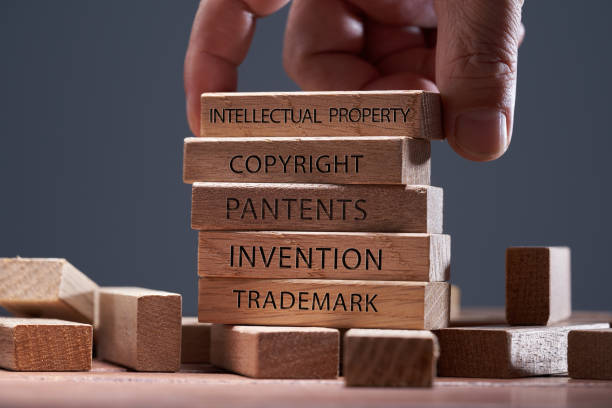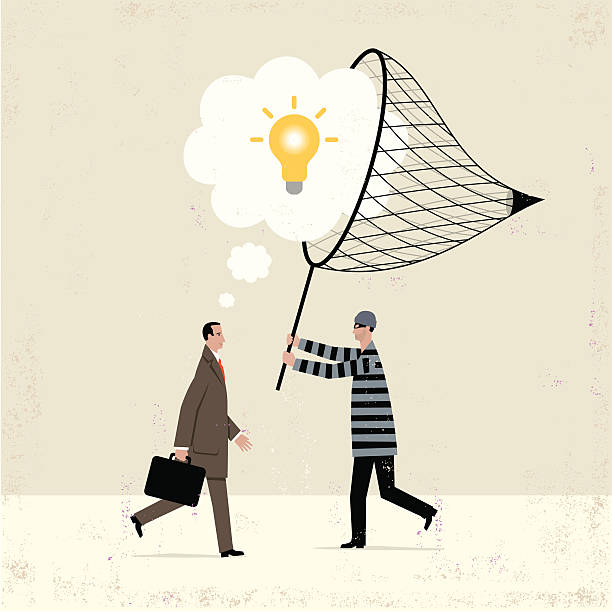Introduction
In the ever-evolving landscape of technology and law, the integration of Artificial Intelligence (AI) into Intellectual Property (IP) law has emerged as a transformative force. This dynamic synergy between cutting-edge technology and legal frameworks is ushering in a revolution that promises to redefine the way we manage, protect, and enforce intellectual property rights. This comprehensive exploration aims to unravel the profound impact of AI on IP law, shedding light on its diverse applications, challenges, and the potential it holds for reshaping the legal industry.

Understanding Intellectual Property Law
Intellectual Property (IP) law is a branch of law that deals with the protection of creations of the mind, fostering innovation and creativity by providing legal rights to those who invent, design, or create. This multifaceted field encompasses various forms of intellectual creations, each deserving a unique set of legal protections. To truly grasp the significance of IP law, it’s essential to explore its fundamental categories and the mechanisms through which it safeguards the fruits of human ingenuity.
Categories of Intellectual Property
A. Patents
Patents are legal instruments that grant inventors exclusive rights to their inventions for a specified period, typically 20 years. To be eligible for a patent, an invention must be novel, non-obvious, and industrially applicable. The patent system encourages innovation by providing inventors with a monopoly on their creations, allowing them to recoup investments and profit from their ingenuity.
B. Trademarks
Trademarks are symbols, names, or devices that distinguish goods or services from those of others. Their primary purpose is to protect consumers from confusion and deception in the marketplace. Trademark owners can register their marks with government authorities, gaining exclusive rights to use those marks in connection with specific goods or services. Famous examples include logos, brand names, and slogans.
C. Copyrights
Copyrights protect original works of authorship, such as literary, artistic, and musical creations. Unlike patents, copyrights arise automatically upon the creation of a work. The copyright holder has the exclusive right to reproduce, distribute, perform, and display the work. Copyright protection typically lasts for the life of the author plus 70 years, fostering the creation and dissemination of diverse forms of artistic expression.
D. Trade Secrets
Trade secrets refer to confidential business information that provides a competitive advantage. Unlike patents, trademarks, and copyrights, trade secrets do not involve registration with government authorities. Instead, protection relies on the maintenance of secrecy. Common examples of trade secrets include formulas, processes, and customer lists.
Legal Mechanisms for Protection
A. Registration
In many jurisdictions, inventors and creators can register their intellectual property to strengthen legal protection. This registration process involves submitting an application and, upon approval, receiving a certificate of registration. Registration provides several benefits, including notice to the public of the creator’s rights and the ability to enforce those rights through legal action.
B. Enforcement
Intellectual property rights are only as strong as their enforcement. Legal remedies for IP infringement include injunctions, damages, and, in some cases, criminal penalties. IP holders can take legal action against those who violate their exclusive rights, seeking to stop the unauthorized use and obtain compensation for any damages incurred.
C. Licensing and Transfer
Intellectual property rights are often valuable assets that can be licensed or transferred. Licensing allows third parties to use the IP under specified conditions, while transfer involves the sale or assignment of those rights. These transactions enable creators to monetize their intellectual property and facilitate the broader utilization of innovative ideas and creative works.
International Considerations
Intellectual property is not confined by national borders. International agreements and treaties, such as the Agreement on Trade-Related Aspects of Intellectual Property Rights (TRIPS), seek to harmonize intellectual property standards across countries. This international framework facilitates the global protection and enforcement of intellectual property rights, essential in an increasingly interconnected and digital world.
Emerging Issues
A. Digital Technology and IP
The digital age has brought forth new challenges and opportunities for IP law. Issues such as online piracy, digital rights management, and the protection of software innovations have become focal points in the evolution of intellectual property regulation. Striking a balance between protecting creators’ rights and promoting technological advancement remains a complex and ongoing challenge.
B. Bioethics and Biotechnology
Advances in biotechnology raise ethical and legal questions concerning the patenting of living organisms, genetic material, and medical innovations. The intersection of IP law and bioethics is a dynamic area where legal frameworks must adapt to address the unique challenges posed by rapidly evolving technologies.
In essence, intellectual property law plays a pivotal role in fostering innovation, creativity, and economic growth. By granting creators exclusive rights to their inventions, designs, and creative works, IP law incentivizes the development of new ideas and the dissemination of knowledge. As the technological and cultural landscape continues to evolve, intellectual property law must adapt to address emerging challenges, ensuring a delicate balance between protection and the promotion of progress. Whether in the realms of patents, trademarks, copyrights, or trade secrets, the principles of intellectual property law serve as a crucial foundation for the advancement of human ingenuity and the protection of our collective intellectual heritage.

AI in Intellectual Property Law: A Transformative Partnership
A. Patent Search and Analysis
Traditionally, the process of patent search and analysis has been a laborious task, requiring legal professionals to meticulously sift through extensive databases to assess the novelty and inventiveness of an idea. Enter AI, the game-changer in patent law. AI algorithms can rapidly analyze vast datasets, expediting the identification of prior art and the evaluation of a concept’s patentability. This not only saves time but also significantly enhances the accuracy of the patent search process.
B. Predictive Analytics for Patent Prosecution
In the realm of patent prosecution, the journey to secure a patent from a government agency, AI is wielding predictive analytics as a potent tool. By scrutinizing historical data on patent office decisions, AI algorithms can predict the likelihood of success in obtaining a patent for a specific invention. This not only accelerates the prosecution process but also empowers legal professionals with data-driven insights, enabling them to make informed decisions regarding patent applications.
Trademark Protection and Brand Management
A. Trademark Search and Clearance
AI technologies are revolutionizing the way trademarks are searched and cleared for registration. Trademark searches, which traditionally involved manual scrutiny of databases, have now been streamlined through AI. These intelligent algorithms can swiftly scan vast repositories of trademarks, flagging potential conflicts and expediting the clearance process. This not only saves valuable time but also significantly enhances the accuracy of identifying potential issues.
B. Brand Monitoring and Enforcement
Once a trademark is registered, the battle for brand protection continues. AI-powered tools now play a pivotal role in brand monitoring and enforcement. By continuously scanning online and offline channels, these tools can identify potential trademark infringements, counterfeiting activities, and unauthorized use of brand assets. This proactive approach allows businesses to address potential issues swiftly, mitigating the risk of legal disputes and brand dilution.
Copyright Protection and Content Management
A. Automated Copyright Compliance
The landscape of copyright protection is undergoing a seismic shift with the integration of AI. Automated systems powered by AI are now instrumental in ensuring copyright compliance and detecting infringements. Content creators and publishers can utilize these tools to monitor digital platforms for unauthorized use of their copyrighted material. The automated systems can issue takedown notices, relieving legal teams of some of the burden and ensuring the robust enforcement of intellectual property rights in the digital realm.
B. Content Creation and Ownership
As AI technology continues to advance, it is giving rise to a new set of challenges related to copyright ownership. The line between human-generated and AI-generated content is becoming increasingly blurred. This poses unique questions about the authorship and ownership of creative works generated by AI. Legal scholars and practitioners are grappling with the need to adapt copyright laws to address these novel challenges and ensure fair and equitable outcomes.
Challenges and Ethical Considerations in Intellectual Property Law
The integration of technology, particularly Artificial Intelligence (AI), into intellectual property (IP) law brings forth a myriad of opportunities but also presents significant challenges and ethical considerations. As we navigate this evolving landscape, it’s essential to address these issues to ensure that the use of AI in IP law aligns with ethical standards, fairness, and the overall objectives of the legal system.
1. Bias in AI Algorithms
Challenge: One of the primary concerns in the use of AI in IP law is the potential for bias in algorithms. AI systems learn from historical data, and if this data contains biases, the algorithms may perpetuate and even amplify these biases. In the context of IP law, biased algorithms could lead to unfair outcomes, impacting the granting of patents or the enforcement of intellectual property rights.
Ethical Consideration: Ensuring fairness and impartiality in AI algorithms is a paramount ethical consideration. Legal professionals, AI developers, and policymakers must work collaboratively to identify and rectify biases in AI systems used in IP law. This may involve ongoing monitoring, transparency in algorithmic decision-making, and continuous efforts to address and mitigate bias.
2. Data Privacy and Security
Challenge: The use of AI in IP law involves the processing and analysis of vast amounts of sensitive information. Protecting this data from unauthorized access, breaches, or misuse is a critical challenge. Legal professionals must navigate the complex landscape of data privacy and security to ensure compliance with regulations such as GDPR (General Data Protection Regulation).
Ethical Consideration: Respecting the privacy rights of individuals and entities involved in IP law cases is an ethical imperative. Legal practitioners and AI developers must implement robust security measures, adopt privacy-by-design principles, and uphold the highest standards of confidentiality. Transparent communication regarding data handling practices is essential to maintain trust in the use of AI in IP law.
3. Ethical Implications of AI-Generated Content
Challenge: As AI technology advances, the line between human-generated and AI-generated content becomes increasingly blurred. This poses unique challenges related to copyright ownership and raises questions about the authenticity and originality of creative works generated by AI.
Ethical Consideration: Addressing the ethical implications of AI-generated content requires a reevaluation of copyright laws. Legal scholars, policymakers, and practitioners must collaboratively explore frameworks that ensure fair attribution, ownership, and protection of creative works. This may involve defining clear guidelines for identifying AI-generated content and establishing ethical standards for its use.
4. Access to and Affordability of AI Technology
Challenge: The deployment of AI tools in IP law may lead to a digital divide, where entities with limited resources face challenges accessing and affording advanced AI technologies. This could potentially create disparities in the ability to leverage AI for patent searches, trademark monitoring, and other aspects of IP law.
Ethical Consideration: Ensuring equitable access to AI technology in the legal landscape is an ethical imperative. Efforts should be made to address economic disparities, promote inclusivity, and provide mechanisms for smaller entities to access AI tools that enhance their capabilities in navigating the complexities of IP law.
5. Impact on Employment in the Legal Industry
Challenge: The integration of AI in IP law has the potential to automate certain tasks traditionally performed by legal professionals, raising concerns about the impact on employment in the legal industry.
Ethical Consideration: Balancing the benefits of AI-driven efficiency with the potential impact on employment requires ethical considerations. Legal professionals, educators, and policymakers should collaborate to anticipate changes in the industry, adapt educational curricula to include AI-related skills, and implement measures to support the workforce through transitions.
6. Ethical Use of AI in Legal Decision-Making
Challenge: AI tools in IP law can assist in decision-making processes, but ethical questions arise when considering the extent to which AI should influence or determine legal outcomes. Striking the right balance between human judgment and AI assistance is a complex challenge.
Ethical Consideration: Ensuring that AI tools are used as aids to legal professionals rather than as autonomous decision-makers is an ethical imperative. Establishing clear guidelines for the ethical use of AI in legal decision-making, preserving human agency, and maintaining accountability are critical considerations.
In sum, as AI continues to shape the landscape of intellectual property law, addressing challenges and ethical considerations is fundamental to building a robust and fair legal framework. By fostering transparency, inclusivity, and accountability, the legal community can harness the transformative power of AI while upholding the ethical standards that underpin the principles of justice, fairness, and respect for individuals’ rights. As we navigate these challenges, a collaborative and interdisciplinary approach involving legal experts, technologists, ethicists, and policymakers is crucial to ensuring that AI in IP law serves the interests of society as a whole.

The Future of AI in IP Law
As the integration of Artificial Intelligence (AI) continues to reshape the landscape of intellectual property (IP) law, the future holds a dynamic interplay of innovation, challenges, and opportunities. From enhancing efficiency in patent searches to revolutionizing trademark protection and copyright enforcement, the trajectory of AI in IP law is poised to bring about transformative changes. Let’s explore the potential scenarios and considerations that will define the future of AI in IP law.
1. Enhanced Decision-Making and Predictive Analytics
The future promises a leap in the capabilities of AI to support legal professionals in decision-making. Advanced AI algorithms will analyze vast datasets, predict outcomes in patent prosecution, and provide nuanced insights for strategic decision-making. Predictive analytics will become more refined, offering legal practitioners a competitive edge in navigating the complexities of IP law.
2. Collaboration Between Humans and AI
The future of AI in IP law is about collaboration, not replacement. Legal professionals will increasingly work in tandem with AI tools, leveraging the strengths of both human judgment and machine efficiency. This collaboration will enable legal experts to focus on high-level tasks that require creativity, interpretation, and strategic thinking.
3. Evolving Patent Landscape
The patent landscape will witness a revolution fueled by AI. Improved patent search algorithms will expedite the identification of prior art, making the patent examination process more efficient. AI-generated inventions and innovations in emerging technologies like biotechnology and artificial intelligence itself will challenge existing frameworks, prompting legal scholars to redefine patentability criteria.
4. AI and Trademark Protection
AI’s role in trademark protection will expand, with advanced tools monitoring a myriad of online and offline channels for potential infringements. Real-time brand monitoring will become the norm, allowing businesses to proactively address trademark issues before they escalate.
5. Copyright in the Digital Age
Copyright enforcement will be revolutionized by AI’s ability to detect and address online copyright infringement. Automated systems will efficiently issue takedown notices, protecting the rights of content creators in the digital realm. Balancing copyright protection with the principles of fair use and freedom of expression will be an ongoing challenge. The legal community will need to address issues related to AI-generated content and determine ownership and attribution in this evolving landscape.
6. Ethical and Regulatory Frameworks
The future of AI in IP law will see the development of robust ethical and regulatory frameworks. Legal professionals, policymakers, and technologists will collaboratively establish guidelines that ensure the ethical use of AI, transparency in decision-making, and adherence to privacy and data protection standards. Crafting effective and globally harmonized regulations poses a challenge. Legal systems will need to adapt swiftly to technological advancements, ensuring that regulations strike a balance between fostering innovation and safeguarding fundamental rights.
7. Accessibility and Inclusivity
Efforts will be made to enhance the accessibility and affordability of AI tools in IP law. Smaller entities and individuals will have greater access to AI-driven solutions, promoting inclusivity and democratizing the benefits of advanced technology. Bridging the digital divide and addressing disparities in access to AI technology will require concerted efforts from legal practitioners, technology providers, and policymakers.
The future of AI in IP law holds immense promise, with the potential to revolutionize how intellectual property is protected, enforced, and leveraged for innovation. As we navigate this future, it is imperative for the legal community to stay abreast of technological advancements, collaborate across disciplines, and proactively address the ethical, legal, and societal implications of AI in IP law. By embracing the possibilities while navigating the challenges, the legal profession can ensure that AI becomes a powerful ally in advancing the principles of justice, fairness, and the protection of intellectual property rights in the digital age.
Conclusion
In conclusion, the integration of AI in IP law is ushering in a revolutionary era, promising unprecedented efficiency, accuracy, and innovation. From expediting patent searches to streamlining trademark clearance and enhancing copyright enforcement, AI is reshaping the way legal professionals navigate the intricate world of intellectual property. While challenges such as bias and data privacy demand careful consideration, the potential benefits far outweigh the drawbacks. As the legal industry embraces the possibilities of AI, staying informed and adapting to new technologies will be crucial. The intersection of AI and IP law is a dynamic space where innovation and legal protection converge, shaping a future where these two forces work hand in hand to create a more responsive and dynamic legal landscape. The game-changing revolution is underway, and those who embrace it will lead the way into a future where AI and IP law redefine the boundaries of what is possible in the realm of intellectual property protection.

Leave a Reply